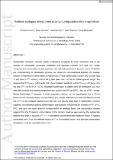| dc.contributor.author | Horton, Forrest | |
| dc.contributor.author | Nielsen, Sune | |
| dc.contributor.author | Shu, Yunchao | |
| dc.contributor.author | Gagnon, Alan | |
| dc.contributor.author | Blusztajn, Jerzy | |
| dc.date.accessioned | 2022-02-16T15:14:33Z | |
| dc.date.available | 2022-02-16T15:14:33Z | |
| dc.date.issued | 2021-01-27 | |
| dc.identifier.issn | 1525-2027 | |
| dc.identifier.issn | 1525-2027 | |
| dc.identifier.uri | https://hdl.handle.net/1721.1/140398 | |
| dc.description.abstract | Carbonatite volcanism remains poorly understood compared to silicic volcanism due to the scarcity of carbonatite volcanoes worldwide and because volcanic H2O and CO2—major components in carbonatite volcanic systems—are not well preserved in the rock record. To further our understanding of carbonatite genesis, we utilize the non-traditional thallium (Tl) isotope system in Khanneshin carbonatites in Afghanistan. These carbonatites contain 250–30,000 ng/g Tl and have ε205Tl values (−4.6 to +4.6) that span much of the terrestrial igneous range. We observe that δ18OVSMOW (+8.6‰ to +23.5‰) correlates positively with δ13CVPDB (−4.6‰ to +3.5‰) and ε205Tl up to δ18O = 15‰. Rayleigh fractionation of calcite from an immiscible CO2-H2O fluid with a mantle-like starting composition can explain the δ18O and δ13C—but not ε205Tl—trends. Biotite fractionates Tl isotopes in other magmatic settings, so we hypothesize that a Tl-rich hydrous brine caused potassic metasomatism (i.e., biotite fenitization) of wall rock that increased the ε205Tl of the residual magma-fluid reservoir. Our results imply that, in carbonatitic volcanic systems, simultaneous igneous differentiation and potassic metasomatism increase ε205Tl, δ18O, δ13C, and light rare earth element concentrations in residual fluids. Our fractionation models suggest that the Tl isotopic compositions of the primary magmas were among the isotopically lightest (less than or equal to ε205Tl = −4.6) material derived from the mantle for which Tl isotopic constraints exist. If so, the ultimate source of Tl in Khanneshin lavas—and perhaps carbonatites elsewhere—may be recycled ocean crust. | en_US |
| dc.language | en | |
| dc.publisher | American Geophysical Union (AGU) | en_US |
| dc.relation.isversionof | http://dx.doi.org/10.1029/2020gc009472 | en_US |
| dc.rights | Article is made available in accordance with the publisher's policy and may be subject to US copyright law. Please refer to the publisher's site for terms of use. | en_US |
| dc.source | Wiley | en_US |
| dc.title | Thallium Isotopes Reveal Brine Activity During Carbonatite Magmatism | en_US |
| dc.type | Article | en_US |
| dc.identifier.citation | Horton, F., Nielsen, S., Shu, Y., Gagnon, A., & Blusztajn, J. (2021). Thallium isotopes reveal brine activity during carbonatite magmatism. Geochemistry, Geophysics, Geosystems, 22, e2020GC009472. | en_US |
| dc.contributor.department | Woods Hole Oceanographic Institution | |
| dc.relation.journal | Geochemistry, Geophysics, Geosystems | en_US |
| dc.eprint.version | Author's final manuscript | en_US |
| dc.type.uri | http://purl.org/eprint/type/JournalArticle | en_US |
| eprint.status | http://purl.org/eprint/status/PeerReviewed | en_US |
| dspace.date.submission | 2022-02-09T20:12:15Z | |
| mit.journal.volume | 22 | en_US |
| mit.journal.issue | 3 | en_US |
| mit.license | PUBLISHER_POLICY | |
| mit.metadata.status | Authority Work Needed | en_US |
